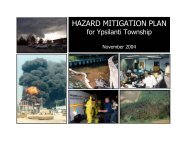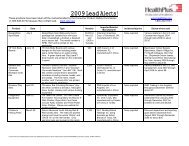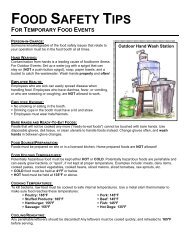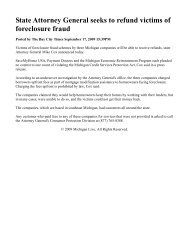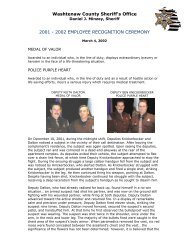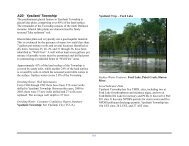Water Protection Activities in Washtenaw County
Water Protection Activities in Washtenaw County
Water Protection Activities in Washtenaw County
Create successful ePaper yourself
Turn your PDF publications into a flip-book with our unique Google optimized e-Paper software.
Challenge # 15 Po<strong>in</strong>t Source Discharges<br />
Po<strong>in</strong>t source waste discharges to surface water s are regulated<br />
by the Clean <strong>Water</strong> Act via the National Pollutant Discharge<br />
Elim<strong>in</strong>ation System (NPDES). Municipal NPDES permits<br />
specify the quality and quantity of treated wastewater permitted<br />
to be discharged at a particular location. There are 47 NPDES<br />
permits for surface water discharges <strong>in</strong> <strong>Washtenaw</strong> <strong>County</strong>.<br />
Information can be found at the follow<strong>in</strong>g sites:<br />
● EPA Envirofacts Data Warehouse<br />
○ http://www.epa.gov/enviro/<strong>in</strong>dex_java.html<br />
● DEQ NPDES<br />
○ http://www.michigan.gov/deqnpdes<br />
Po<strong>in</strong>t Sources Discharges Response Objective:<br />
Control the discharge of regulated pollutants, to ma<strong>in</strong>ta<strong>in</strong> or<br />
atta<strong>in</strong> WQS <strong>in</strong> <strong>Washtenaw</strong> <strong>County</strong>, and to m<strong>in</strong>imize public<br />
exposure to waters with elevated levels of contam<strong>in</strong>ants<br />
result<strong>in</strong>g from pipe discharges.<br />
Po<strong>in</strong>t Source Discharges Response Assessment:<br />
The NPDES permitt<strong>in</strong>g system is <strong>in</strong> place and effectively<br />
regulates po<strong>in</strong>t source pollutant discharges to surface waters. It<br />
is the primary response to po<strong>in</strong>t source discharges and has<br />
historically been used effectively.<br />
What protection activities<br />
address the challenge of<br />
po<strong>in</strong>t source pollution?<br />
Clean <strong>Water</strong> Act<br />
<strong>Water</strong> Monitor<strong>in</strong>g<br />
Illicit Discharge Elim<strong>in</strong>ation<br />
57<br />
The Illicit Discharge Elim<strong>in</strong>ation Program is <strong>in</strong> place and<br />
ongo<strong>in</strong>g to f<strong>in</strong>d and remediate those discharges that<br />
accidentally or <strong>in</strong>tentionally evade the permitt<strong>in</strong>g program. In<br />
2005, 150 dra<strong>in</strong>s were <strong>in</strong>spected and 17 illicit discharges<br />
connections were identified and corrected<br />
The Huron River has a Total Maximum daily Load (TMDL)<br />
for Phosphorus upstream of Ford and Bellville Lakes.<br />
Po<strong>in</strong>t source dischargers to the Huron River between Portage<br />
Lake and Belleville Lake are implement<strong>in</strong>g voluntary limits<br />
below permit levels for phosphorus. This effort is part of an<br />
overall strategy to reduce the occurrence of algae blooms <strong>in</strong><br />
Ford and Belleville Lakes. See the Middle Huron Initiative at:<br />
http://www.hrwc.org/program/mid.htm<br />
Po<strong>in</strong>t Source – Wastewater Treatment Plants<br />
Wastewater treatment plants are an example of regulated<br />
pollutant discharge. In <strong>Washtenaw</strong> <strong>County</strong> there are eleven<br />
municipal wastewater treatment plants (WWTP), also known<br />
as Publicly Owned Treatment Works (POTWs). POTWs have<br />
a significant effect on water quality because they discharge<br />
treated wastewater primarily <strong>in</strong>to rivers and to a lesser extent<br />
the groundwater. The wastewater discharged at these facilities<br />
receives physical, biological and chemical treatment, yet still<br />
conta<strong>in</strong>s various contam<strong>in</strong>ants. POTWs are not able to treat all<br />
<strong>in</strong>dustrial chemicals, so <strong>in</strong>dustries that are permitted to<br />
discharge chemicals to a POTW must meet specific<br />
requirements through an Industrial Pretreatment Program. For<br />
all these various reasons, POTWs are closely monitored at the<br />
Federal, State and <strong>County</strong> level.



